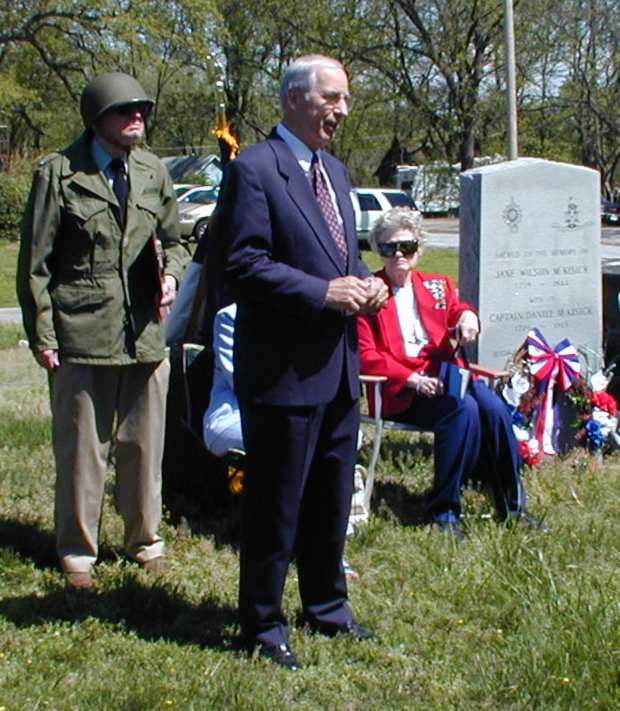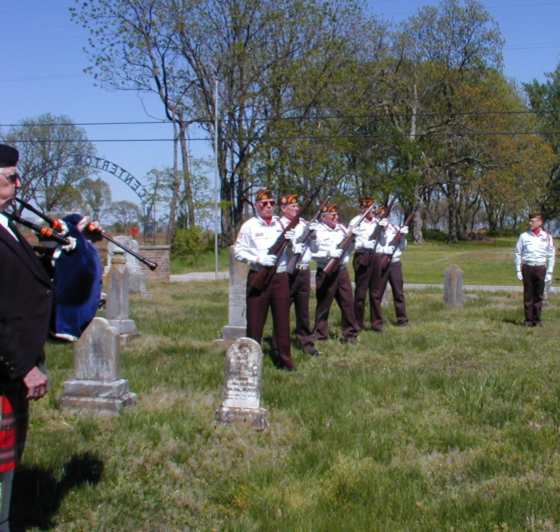Rededication of the Gravestone of Jane Wilson McKisick
Centerton Cemetery, Centerton, Arkansas, April 24, 2003
Text of Address by the Reverend David Williamson, g, g, g, g, grandson
of Daniel McKisick and Jane Wilson McKisick:
On behalf of my sister, Mrs. Sue Williamson Newson, who is with me today,
and all our family, I would like to express appreciation
to Col. Emil Cross, Jr.
and to Mr. Terry Burnside for the
courtesy of the invitation to participate
in this ceremony
today, and for the careful preparation they have made.
We are honored that the James Bright Chapter of the D.A.R. has placed
this headstone at the grave of Jane Wilson McKisick
and that they will officially rededicate
it today.
We are deeply grateful to Bishop Bannan, Mr. Milo Cumpston,
the honor guard of V.F.W. Post 9063 of Bella Vista,
and to Mr. Jack McPhdyen who will
play the bagpipes
as a most suitable
conclusion of the service.

It is altogether fitting that we come today to rededicate this marker,
but our greater opportunity is to remember the life
of this remarkable woman, and to
rededicate ourselves
to those uniquely
American ideals which she personified.

The events of her life exhibit those ideals and the American Experience
in a remarkable way. Her life is a revealing synopsis
of America itself.
She grew up in those years when the people of the colonies in America
were growing indignant at their treatment by their mother
county.
Her father, James Wilson, was a prominent leader among
the patriots or Rowan County, North Carolina.
When Jane was 12 years old her father was appointed as a member
of the Committee of Safety for Rowan County, a committee
which acted for the purposes of independence.
As a young woman, she married Daniel McKisick in 1776, the very year
that the colonists declared themselves to all the world
to be
the Free, Independent, and United States of America.
Daniel, a mature man of 27 at the time of their marriage, was a lieutenant
colonel in the North Carolina Militia, and when the
war came,
the War of the Revolution, he formed
a company,
which he led as
Captain.

In the summer of 1780, he and his company were called into service
by Colonel Frances Locke to meet the threat of an armed
body
of local loyalists or Tories.
That summer had not been favorable to the cause of American liberty.
On May 12, the Americans had suffered their greatest
defeat
in the fall of Charlestown to the
British forces of Gen. Clinton.
The loyalists of North Carolina were emboldened by this victory.
John Moore, a prominent Tory of Lincoln County, called
for the
local loyalists to gather on June
13 near Ramsour’s Mill.
Over the next week local men loyal to the crown continued to gather at
the
encampment until there were between 1200 and 1400 of
them.
Their intention was to join forces with the regular British army
just over the border in South Carolina
On the evening of June 19, the militia led by Colonel Locke, numbering
about 400 men began an all night march toward the mill.
The battle began at dawn on the 20th of June, 1780--a very different
kind of battle which tells us so much about the America
of that day.
There was not a uniform on either side. Not a single British soldier, only
local people loyal to the crown. And on the other side,
only a citizen militia led by local
people
dedicated to independence
and liberty for the new nation.

Every man engaged that day was an American. Most of them knew the men
they were fighting against, as neighbor, friend, or
relative.
The fact that there were not a uniformed army led to one of the most
interesting aspects of the battle: the Tories identified
themselves
by wearing a fresh sprig of green
in their caps.
The patriots, also know as the Whigs, wore patches of white paper or cloth,
which turned out not to be such a good idea, since the
white patch
on the cap turned out to be an excellent
target for Tory riflemen
It is not necessary for me to go into the interesting details of the battle;
it is sufficient to say that the Patriots decisively
whipped
the Tory force of three times their
number.
Losses were heavy on both sides, about 70 killed and
about 100 wounded on each side, including Captain Daniel
McKisick
who left arm was shattered from the
elbow to the sholder
by a rifle ball, which would leave
him handicapped for life.
And here is the best part of the story: someone was sent to tell
Mrs. Mckisick who was at home about 10 miles away.
She left a small child and a baby and went out to the hill by Ramsour’s
Mill,
found her wounded husband, took him to the Rhinehart
house nearby
and cared for him there, until she
could take him back home.
Reared in the home of a prominent Patriot, James Wilson;
married in 1776 to another Patriot, Daniel McKisick;
after Ramsour’s Mill, she is a genuine heroine of the Revolution.
And then in 1807, when she is 48 years old, the McKisick family
becomes pioneers as they move to Bedford County, Tennessee.
Both Daniel and his son James are
prominent leaders
in early day Bedford
County and the state.
When Jane is 69, her Daniel dies at his home near Shelbyville,
and there he is buried, his grave now suitably marked
as a soldier of the Revolution, wounded
in battle.

But the story of Jane Wilson McKisick is not quite over.
Her son James had been appointed by the federal government
as commissioner to the five Indian
tribes:
Chickasaw, Choctaw,
Cherokee, Seminole, Creek.
His responsibilities took him to the Indian Territory in the West,
and that is how he discovered beautiful Benton County,
Arkansas.
He returned to Tennessee with the determination to move his family
there, and in 1835, when his mother was 77 years of
age,
James led a caravan of McKisicks
and Dicksons to Arkansas.
I must hasten to the “rest of the story”, for after the move West,
just 68 years to the day after the Declaration of Independence,
on July 4, 1844, Jane Wilson McKisick
died at 85 years of age.
We honor her again today, and rededicate ourselves to the Spirit of America
which was so notably exhibited in the events of her
life:
+ Her childhood in a family of Patriots
in the years
when the dream
of Independence were born
+ Married in the very year of the
Declaration of Independence
+ Heroine of the Battle of Ramsour’s
Mill in 1780
+ Pioneer with her husband and family
in Tennessee and Arkansas
How fitting that her death would be on the very Day of Independence, July
4, 1844.




